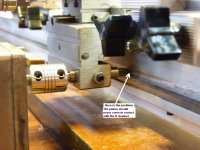Here is my problem.
I added powerfeed to my lathe a week or so ago but for WHATEVER reason my carriage will bind up everytime and basically ruins my powerfeed. It is not "breaking" my pinion gear but it is messing it up pretty bad :angry:. When this happens my pinion gear gets bound up and won't budge. It won't move left, right, or even come out of the eccentric. I literally have to loosen the set screw on the eccentric, take the eccentric out and remove it with the pinion gear still stuck in it and beat the pinion gear out with a punch. Once out I can take the pinion gear and hit it with some 400 sandpaper and it will slide back in the eccentric but I am still getting major binding on my carriage and don't know what to do to correct it.
I have added a delrin gib, lightly lubed the gib, lubed under the rail where the gib slides, and also the bed itself. I am not running a router or anything, just a simple test of the powerfeed to see how fast/slow it moves so there is NOTHING on the carriage, not even a toolpost so there is no added weight. I have also loosened every single set screw that would hold the carriage in place so there is ZERO chance of any screw holding it tight on the bed. Even with the handwheel it has never been EXACTLY smooth but it also has never bound up or had problems moving the carriage until I added the powerfeed. The motor and pinion gear is coupled with an aluminum flex coupling and I have also tried to make my own delrin coupling to connect the motor to the pinion (thinking the "flex" coupling was flexing too much) but am still having the same problems. I can't make one full pass down the lathe bed without the carriage binding up and coming to a complete STOP using the powerfeed. The powerfeed motor is supported VERY good with a bracket, however, it does this same thing with OR without the bracket supporting the powerfeed motor so I am 99% sure it is not a mounting problem with the motor.
Any suggestions and/or recommendations ???? :frown:






